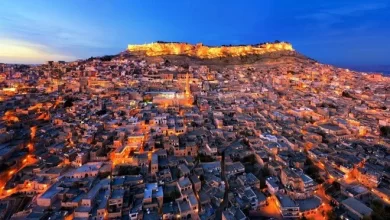Mount Nemrut National Park, Adiyaman

Malatya is located within the borders of Büyüköz village and Kahta of Pütürge district of Adıyaman. It is one of the most magnificent ruins of the Hellenistic period with its tomb, monumental sculptures and unique view, which was built by the King of Commagene, Antiochos I, at the foot of Mount Nemrut at an altitude of 2150 meters. gratitude to the gods and ancestors. Monumental sculptures are spread over the east, west and north terraces. The well-preserved giant statues are made of limestone blocks and are 8-10 meters high. An independent kingdom was established by Mithradates I in the region known as “Commagene” in ancient times and the kingdom gained importance during the reign of his son Antiochos I (62-32 BC). WOMAN. After the loss of the war against Rome in 72 AD, the independence of the kingdom came to an end. The summit of Mount Nemrut is not a settlement, but the tumulus and sanctuaries of Antiochos. The tumulus is at a point that dominates the Euphrates River crossings and plains. It is thought that the king’s bones or ashes were placed in a chamber carved into the bedrock and surrounded by a tumulus 50 meters high and 150 meters in diameter.

Although it is stated in the inscriptions that the tomb of the king is here, it has not been discovered until today. On the east and west terraces, there are lion and eagle statues as well as Antiochos and god-goddess statues. There is a unique lion sign on the west terrace. The sculptures were carved by blending Hellenistic, Persian art and the original art of the Commagene country. In this sense, Mount Nemrut can be called “the bridge of western and eastern civilizations”. There are oak species and some trees within the borders of the National Park. In terms of wildlife, there are bear, wolf, jackal, fox and badger species.

Bridge of Western and Eastern Civilizations: Nemrut
Adoptives and some individuals reside in the National Park. In the wild there are species of bears, wolves, jackals, foxes and badgers. With the disappearance of the Commagene empire from the stage of history, it was left to loneliness for 2 thousand years in the affairs of Mount Nemrut. While visiting the region in 1881, I came across the German engineer Karl Sester’s sculptures on Mount Nemrut and the German ruins of the Consul in Izmir called “Find Assyria”. Not being able to see the Greek inscriptions with the great excitement of the giant statues and not being able to pass over the pedestals on which the statues of the gods sit is Sester. In 1882, Otto Puchstein and Karl Sester created the creation in Nimrod. Osman Hamdi Bey, Director of the Museum-i Hümayun (Imperial Museum), came with a team in 1883 and worked in Nemrut. After World War II, the American archaeologist Theresa Goell and the German Karl Doerner conducted excavations, research and investigations in Nemrut and the region. A 100-kilometer road passes over Nemrut on the Malatya-Pütürge-Tepehan road.







